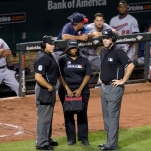Here's NASA's three-step plan to colonize Mars
On Thursday, NASA released a three-step plan to bring humans to Mars sometime in 2030. It’s simple! Sort of.
In a report outlining the plan, the space agency did not hesitate to classify this as a colonial mission. “Like the Apollo Program, we embark on this journey for all humanity,” NASA noted, adding, “Unlike Apollo,we will be going to stay… We are developing the capabilities necessary to get there, land there, and live there.”
The agency’s recent confirmation that there is liquid water on Mars is a good thing for those who want to set up camp on the red planet, but it doesn’t mean living on Mars will be easy. For one thing, the water is not drinkable—scientists will still need to figure out a way to use it as a resource that could support life. For another, the challenges that make a hypothetical journey to Mars so dangerous, like sustained exposure to dangerous radiation, remain.
-

-

-

-

-

-

-

-

-

-

-

-

-

-

-

-

-

-

-

-

-

-

-

-

-

-

-

-

-

-

-

-

-

-

-

-

-

-

-

-

-

-

-

-

-

-

-

-

-

-

-

-

-

-

-

-

-

-

-

-

-

-

-

-

-

-

-

-

-

-

-

-

-

-

-

-

-

-

-

-

-

-

-

-

-

-

-

-

-

-

-

-

-

-

-

-

-

-

-

-

-

-

-

-

-

-

-

-











































































































